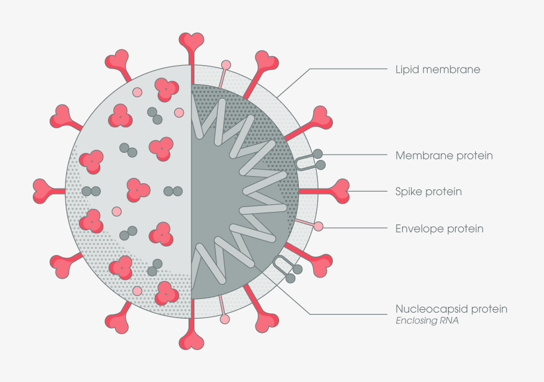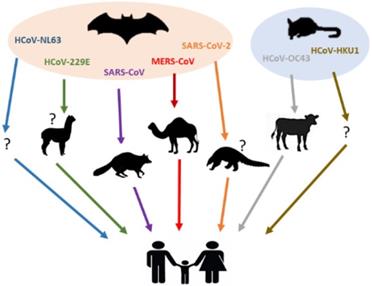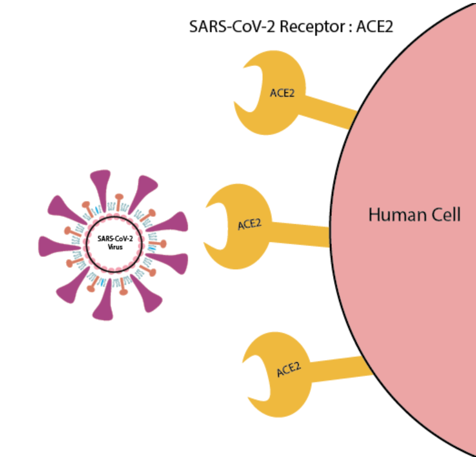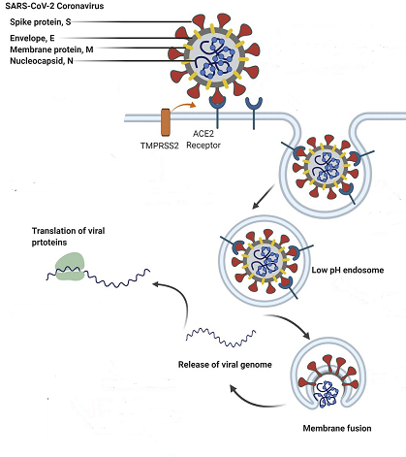COVID-19 Structure
The COVID-19 virus is composed of spike proteins, envelope and membrane proteins, and nucleocapsid proteins.
Spike proteins are located on the outer surface of the protein and are the first part of the virus that comes in contact with the cell. They bind to the ACE2 receptor on the cell, leading to them entering the cell. Envelope and membrane proteins primarily form the lipid bilayer that surrounds the virus. Nucleocapsid proteins wrap around the RNA genome and stabilize it.

Attachment
Viruses usually enter the body through a variety of systems, such as the respiratory system, the gastrointestinal tract, the urogenital system, a wound in the skin, or through the eyes.
Whether or not you get an infection from the virus, however, depends on where the virus enters, whether the virus encounters a permissive cell, how much of the virus is in your body, and the extent of the immune response.
The only way viruses can enter cells and replicate themselves is through attachment. To attach, they need to find a specific cell with receptors that they can bind to. Since viruses are highly specific to their hosts, they must find an exact match. In the case of COVID-19, the spike proteins perfectly match the ACE2 receptor.

Although SARS-CoV-2 usually infects humans, it can also infect other organisms (but will have less of an effect on them). However, since COVID can affect many animals, it can also jump from one species to another, making them zoonotic diseases.
Although it may seem that viruses attach tightly to cells, in reality, they use non-covalent bonds when interacting with the cells. To find the receptor it must bind to, the virus travels along the outer surface of the cell until it finds a receptor, which is usually a glycoprotein (for COVID-19, it's ACE2). The receptor that the virus binds to can be identified using a number of techniques such as molecular cloning, affinity chromatography, and antibodies:
- Molecular cloning is when mRNAs are expressed in a cell (by synthesizing proteins) and the receptor is identified using the proteins that were synthesized.
- Affinity chromatography involves the use of a column containing receptor that binds proteins from the cell membrane. The proteins that bind to receptors will identify the receptors.
- Antibodies can be developed and used to determine which antibody blocks the binding of a virus to the receptors.
But how did scientists discover COVID-19's receptor?
This article published in the journal Nature details the process used to determine that ACE2 was the receptor that COVID binds to. Before COVID-19, there were two receptors that were used to bind to SARS-CoV. Unfortunately, SARS-CoV has a distinctly different spike protein from SARS-CoV2. The spike protein contained two domains (parts of the protein that do not change). Using flow cytometry, the scientists were able to separate the cells based on their fluorescence. They discovered that S1 bound to VeroE6 cells, but not to 293T cells. The researchers then had to determine which protein in VeroE6 binded to S1. To do this, they labeled three proteins with a tag and then mixed the three proteins with VeroE6 membrane proteins. Using an antibody, the tags were precipitated and the proteins bound to the tag were run on gel electrophoresis. One of the proteins was the cell surface protein ACE2, but the scientists had to confirm that this was the protein. To do this, the S1 protein was tagged and added to the cells. It was then labeled with an antibody that would bind to the tag. The results shows that ACE2 was, in fact, the receptor.
How does the virus enter the cell after attachment?
SARS-CoV-2 can enter the cell through either priming the spike proteins or through receptor mediated endocytosis.
During spike protein priming, the protease TMRPSS2 cleaves S2, leading to a conformational change. A second protease, furin, can also facilitate entry. It is believed that furin led to the increased transmissibility of SARS-CoV-2 compared to SARS.
Receptor mediated endocytosis occurs when the virus binds to a specific receptor. The cell membrane folds in and carries the virus into the cell inside a vesicle. Once the virus is in the cell, it separates from the receptor and is released from the endosome.
